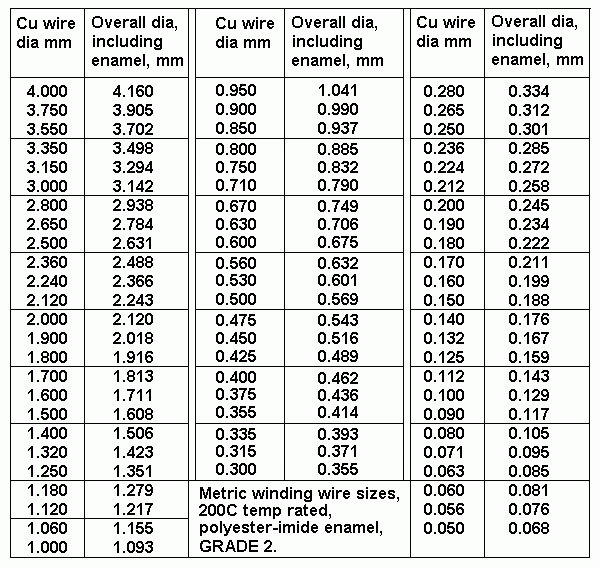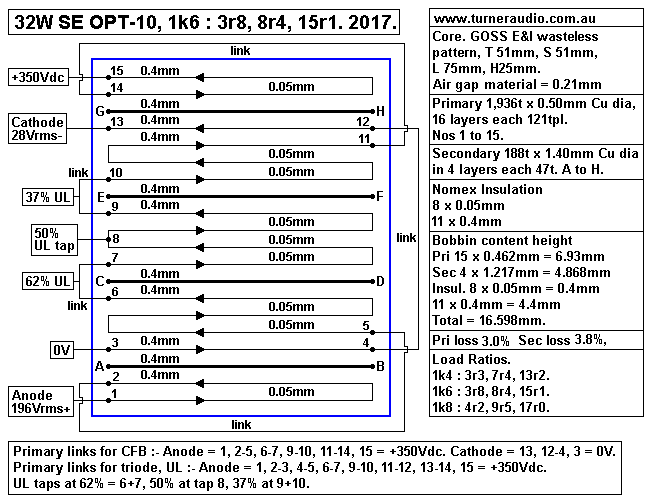32W
SE OPT-10 for 13E1.
OPT-10 design steps 1 to 26,
for 1 x 13E1, or for 2 x KT120, 3 x KT88, 6550, 4 x EL34, 6CA7,
6L6GC, KT66, 5881.
Use 12% to 25% CFB, or 40% to 66% UL, or Triode connected for
slightly less Po.
1. Calculate RLa for 13E1 beam tetrode, or equal tubes, for Po =
32W, with Ea +350V.
For 13E1, max anode Pda = 70W.
RLa = 0.9 x Ea squared / Idle Pda = 0.9 x 350V x 350V / 70W =
1,575r. Round up to 1,600r.
2. Calculate Afe = 450 x sq.rt Po sq.mm = 450 x sq.rt 32 =
50.45mm.
Select core to suit from standard sizes, and to suit a standard
molded bobbin,
Try wasteless E+I T 51mm x S 51mm x L 75mm x H25mm, Afe =
2,500sq.mm,
ML = average TL = 280mm.
Note. Alternative is T 44mm x S 62mm, but winding losses will be
higher.
3. Calculate Va for 32W to RLa 1,600r = sq.rt ( 32W x 1,600r ) =
227Vrms.
Calculate minimum Idc = 1.414 x ( Va / RLa ) = 1.414 x 227Vrms /
1,600r = 200mAdc.
4. Calculate theoretical primary turns Np for Bac = 0.7Tesla, Bdc
= 0.7Tesla, Fsat = 14Hz, 227Vac.
Np = 22.6 x 227V x 10,000 / ( 50mm x 50mm x 14Hz x 0.7Tesla ) =
2,093t.
5. Calculate oa dia primary wire = sq.rt ( 0.28 x 75mm x 25mm /
2,093t ) = 0.500mm.
Note. 0.28 factor x window area works for all OPTs.
Table 1. Grade 2 winding wire sizes.

Try wire with oa dia = 0.516mm, Cu dia = 0.45mm.
6. Calculate bobbin winding width Bww = 75mm less 2 x 2mm cheeks =
71mm.
7. Calculate Primary tpl = 0.97 x Bww / oa dia chosen = 0.97 x
71mm x 0.516mm = 134tpl.
8. Calculate primary layers = th Np / tpl = 2,093t / 134t = 15.62
layers, use 16 layers.
Calculate revised Np = 16 x 134t = 2,144t.
9. Calculate RwP = ( Np x TL ) / ( 44,000 x Cu dia squared )
= 2,144t x 280mm / ( 44,000 x 0.45 x 0.45 ) = 67.4r
10. Calculate Primary loss = 100% x 67.4 / ( 67.4r + 1,600r ) =
4.0%.
Is there a lower loss alternative?
11. Try Pri wire size = 0.50mm, oa dia = 0.569mm.
12. Calculate Pri tpl = 0.97 x 71mm / 0.569 = 121tpl.
13. Try Ns = 16 layers x 121t = 1,936t. This is 0.92 x th Ns, so
Fsat may be at 15Hz instead of
planned 14Hz = OK.
14. Calculate RwP = 1,936t x 280mm / ( 44,000 x 0.5mm x 0.5mm ) =
49.28r.
15. Calculate Pri loss = 100% x 49.3r / 1,649.3r = 2.989% = OK.
16. Choose suitable P and S interleaving pattern for OP-10.
Refer to selection guide tables in se-output-trans-calc-2.html
18. Choose insulation thicknesses.
For primary, 14 layers are at +350Vdc potential 2 CFB layers plus
all Sec layers are at near 0Vdc
potential.
Use 0.4mm plastic insulation between Pri windings with 350Vdc
difference, and use 0.4mm between all
Sec layers and primary layers. Use 0.05mm between primary layers
with same Vdc.
19. Calculate bobbin content winding height :-
Primary wire = 16 x 0.569mm oa dia = 9.104mm.
Insulation 0.05mm between Pri layers x 9 = 0.45mm.
Insulation 0.4mm between Pri and Sec, and Pri to Pri for CFB x 10
= 4.0mm.
Insulation 0.4mm cover over all windings = 0.4mm
Sub total = 13.954mm. Allowed height = 0.8 x bobbin H 25mm = 20mm.
Therefore height for Sec = 20mm - 13.954mm = 6.046mm.
15. Calculate Sec turns.
Calculate largest oa dia for Sec = 6.046mm / 4 layers = 1.5115mm
Choose nearest wire size from Table 1 = 1.506mm oa dia = 1.40mm Cu
dia.
Calculate theoretical Sec tpl = Bww / chosen wire size = 71mm /
1.506mm = 47.14 turns, omit fraction,
tpl = 47t.
16. Calculate load RL for th Sec tpl chosen TR = 1,936t / 47t =
41.19 : 1, ZR = TR squared = 1,698 :1.
Load for 47t = 1,600r / 1.698 = 0.942r
17. What load matches are possible based on 47tpl ?
4 x 47t layers can be arranged for 2 // ( 47t+47t ). Ns = 94t for
4 x 0.942r = 3.77r.
4 x 47t layers can be 47t + 2 // 47t + 47t. Ns = 141t for 8.48r.
4 x 47t layers can be arranged for 4 x 47t all in series. Ns =
188t for 15.08r.
Are there 3 load matched between 3r3 and 20r? YES. we may proceed.
18. Calculate RwS and loss for RL = 3.77r = 94t x 280mm / ( 44,000
x 1.4mm x 1.4mm x 2 ) = 0.152r.
Calculate RwS loss = 100% x 0.152r / ( 0.152r + 3.77r ) = 3.87%.
19. Calculate total loss RwP + RwS = 2.99% + 3.87% = 6.86% and
less than 7% and GOOD.
20. Calculate wanted effective permeability µe for OPT-10.
Bdc = 0.7Tesla = 12.6 x Np x Idc x µe / ( 10,000 x ML )
Thus µe = 0.7T x 10,000 x ML / ( 12.6 x Np x Idc ) = 0.7 x 10,000
x 280 / ( 12.6 x 1,936t x 0.2A ) = 402.
21. Calculate primary inductance Lp = 1.26 x Np squared x Afe x µe
/ ( 1,000,000,000 x ML )
= 1.26 x 1.936 x 1.936 x 50 x 50 x 401 / ( 1,000 x 280 ) = 16.9H.
22. Calculate F where XLp = RLa = 1,600r = 1,600r / ( 6.28 x 16.9H
) = 15.0Hz.
23. Calculate leakage inductance LL looking into primary winding.
LL = 0.417 x Np squared x TL x [ ( 2 x n x c ) + a ] / (
1,000,000,000 x n squared x b )
Where LL = leakage inductance, in Henry, 0.417 and 1,000,000,000
are constants for all equations to
work, Np = primary turns, TL = average turn length around bobbin,
2 is a constant because there areas at
each end of a layer where flux leakage occurs,
n = number of dielectrics, ie, the junctions between layers of P
and S windings, c = the dielectric gap, ie,
the distance between the copper wire surfaces in P and S windings,
a = height of the finished winding in the
bobbin from bottom of first winding to top of last winding,
b = the traverse width of the winding across the bobbin. Distances
are all in mm !
OPT-10, LL = 0.417 x 1,936 x 1,936 x 280 [ ( 2 x 8 x 0.5 ) + 19 ]
/ ( 1,000,000,000 x 8 x 8 x 71 )
= 0.0026H = 2.6mH.
24. Calculate F where XLL = RLa at 100kHz. F = 1,600r / ( 6.28 x
0.0026H ) = 98kHz.
Is F close to 100kHz?
Yes, therefore LL is low enough, and F is far enough above audio
band and amp will easily be stabilized
for CFB and GNFB.
25. Calculate the air gap required, Ag = ML x ( µ - µe ) / ( µ x
µe ).
Air gap is total air gap within Magnetic Length ML for iron,
µ is maximum for E&I where Es are butted against
Is with no air gap, and µe is effective µ when air gap is present
to obtain wanted µe calculated above for the Bdc
for Idc flow.
Samples of GOSS E&I may have max µ up to 17,000 with
laminations fully intermeshed but when Es and Is are
assembled in two piles and with no real air gap, the max µ will be
very much less than when maximally intermeshed.
Typical max µ with no air gap = 1,000.
This occurs because with all Es hard against all Is, there is a
grain direction change of 90 degrees and this acts
like having a n air gap in ML even where there is none.
So µ for equation is the lesser figure of 1,000 for GOSS E&I
cores.
Ag = 280mm x ( 1,000 - 402 ) / ( 1,000 x 402 ) = 0.4156mm.
There are two gaps around the ML for E&I lams, so air gap
material = 0.416mm / 2 = 0.208mm.
26. Draw the bobbin winding layers of wire, insulation, and give
all details of OPT.
Fig 1.

Fig 1 has all info to make the SE OPT-10. Notice that I show load
matches for RLa between 1k4 and 1k8.
The anode RLa varies where secondary speaker loads vary, often
much more than is shown. A speaker
which has nominal or average Z = "4 ohms" may have Z ranging
between 3r0 and 20r0 for different frequencies.
A 32W amp will be able to deal best with the range of speaker Z
variations when OPT has its secondary linked
for the nominal Z given by manufacturer where high Po is needed.
But high Po is rarely ever needed, so all
speakers with Z > 4r0 may be connected to OPT with 4r0 links to
get best Hi-Fi.
But Never Ever use a 4r0 speaker with OPT strapped for 8r4 or
15r1.
OPT-10 may never be used for a single 13E1, but other tubes can be
used.
Ea = 350Vdc, Idc = 200mA. Pda for whatever tubes are connected =
350V x 0.2A = 70W.
For the same idle Ea and Ia and RLa,
2 x KT120 could be used, each with Pda = 35W.
3 x 6550 or KT88 could be used, each with Pda = 23.3W. Pda max
could be 27W each, for anode Po = 37W,
with Ea = 378Vdc and 216mAdc.
4 x EL34, 6CA7, 6L6GC, KT66 could be used with Pda = 17.5W, and if
Pda is allowed to be 21W each,
total Pda = 84W so there can be 38W of anode Po, with Ea 385V and
220mAdc.
Table 1 for METRIC WINDING WIRE SIZES was kindly given to me by a
local Sydney wire and
transformer parts supplier. The original charts supplied contained
all sizes for grade 1 wire with tin enamel
coating and grade 3 with thicker enamel coating. There is no need
for grades 1 and 3 in any OPTs at this
website.
Grade 2 is the only grade stocked by my supplier because it is for
99% of high temperature rated winding
wire for electric motors and stressful industrial applications.
The range of sizes shown are not all obtainable
off the shelf. Some sizes may need to be ordered by the supplier.
The costs per Kg for small amounts of wire
for DIY transformer winding is much higher than the price for a
50Kg spool supplied by a wire maker.
If you only want 4 Kg, then the supplier for small amounts must
wind 4Kg from a 50Kg spool, and the higher
cost is because handling labour is involved. So do NOT grumble
about wire costs, and be thankful that
someone is willing to supply small quantities. I last bought
winding wire in about 2007, and now in 2017,
the supplier may have closed his business because demand for wire
has reduced because so few ppl are
making anything in Australia.
Anyone not used to measuring in millimetres better start getting
used to metric because here the diameter
measurement matters more than the wire gauge, and there are is
AWG, SWG, BS, all very confusing,
and I don't have conversion charts so if you work in gauges and
inches and feet, provide your own solutions.
Before winding anything, make sure you have an accurate micrometer
to confirm that the size is correct.
Back to
Education and DIY directory
Index page

